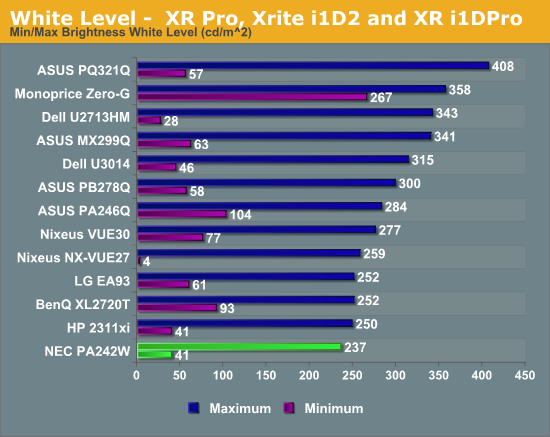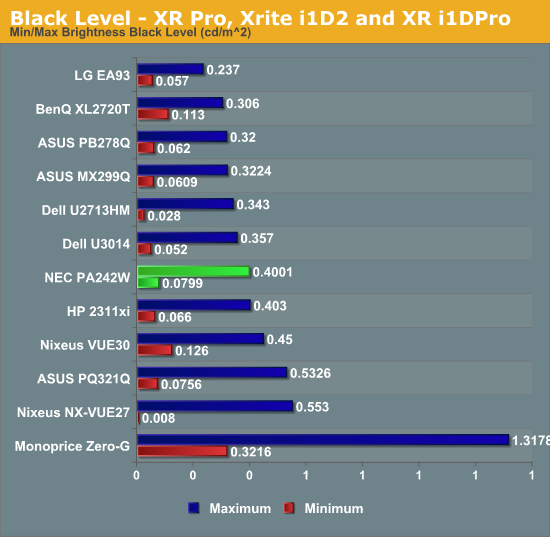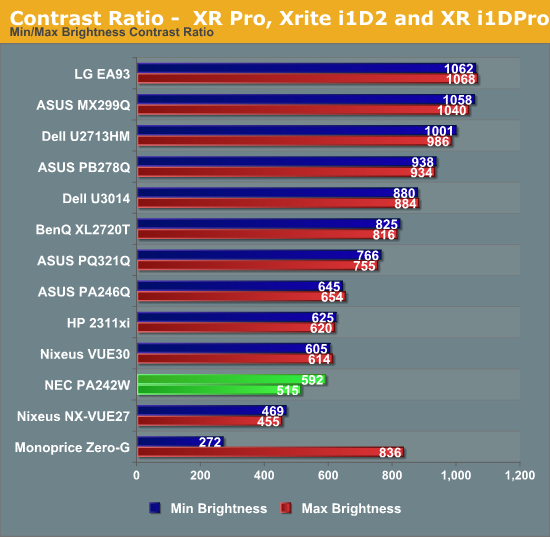NEC PA242W Monitor Review
by Chris Heinonen on September 27, 2013 9:00 AM ESTAs noted on the previous page, NEC limits the upper level of the PA242W backlight to 240 cd/m2. You can go beyond this, but the control turns red to let you know that overall performance is suffering. The construction of the PA242W is designed to make it as uniform and even a display as possible. Pushing the backlight too far will reduce that. No one that is using this monitor in a professional setting would need light output beyond that, so I used that level for the maximum setting here.
If you want to go beyond that, the NEC can produce 287 cd/m^2 at maximum. The minimum setting produces 41.19 cd/m^2, very close to the on screen reading of 40 cd/m^2. The 240 cd/m^2 setting produces 236.7 cd/m^2, also very close. You can adjust this to any level between in 1 cd/m^2 increments. For white level control, the NEC PA242W is unmatched in my experience.

Black level is not quite as good as white level. At the 240 cd/m^2 level we have a black level of 0.4001 cd/m^2 and at the minimum setting we see a level of 0.0799 cd/m^2. That is a very low minimum, but no other monitor has a minimum setting of only 40 cd/m^2 either.

The contrast ratios that result from the above are only fair, 515:1 for the minimum setting and 592:1 for the 240 cd/m^2 level. Curiously the maximum setting produces a contrast ratio of 699:1 indicating that the NEC can do better if you sacrifice uniformity. For movies and TV people typically value contrast ratio above all, but for production work, uniformity might be more important. We will see if this sacrifice winds up being worth it later.











74 Comments
View All Comments
DanNeely - Friday, September 27, 2013 - link
Defect rates on an 8k panel would probably be prohibitive.ZeDestructor - Friday, September 27, 2013 - link
I'm curious on how high they are...If it remains withing tolerable limits, I'd happily take upto 200 dead pixels or something similar...
MrSpadge - Saturday, September 28, 2013 - link
Let's talk again once you have a few dozen permanently white, red green or blue dots right in your primary viewing area!ddriver - Saturday, September 28, 2013 - link
As long as the pixels aren't clustered in a small region dead (dark) pixels will probably not be distinguishable. Stuck bright pixels are a different matter, but at that pixel pitch shouldn't be that much annoying too.ZeDestructor - Saturday, September 28, 2013 - link
As ddriver said,, as long as it isn't in a cluster, its fine. 200-400 dead pixels spread out over a 440+ppi 24" panel at 30-60cm (my view distances for a desktop) will be pretty hard to spot..SodaAnt - Friday, September 27, 2013 - link
I know that I've seen an 8K prototype at 30" before at least, and it was pretty damn beautiful, but as far as I know, the (well known) company that made it hasn't brought it to market yet.speconomist - Friday, September 27, 2013 - link
You mean 32K, as the 20''monitor is 16 times larger than a 5'' inches monitor.garadante - Friday, September 27, 2013 - link
No, it'd be 8k. Yes, it would be 32 megapixels (roughly) but 4k doesn't mean 4 megapixels. It means 4k pixel width. So 8k pixel width is the same as a 1080p panel stacked 4 wide, 4 high.BlakKW - Saturday, September 28, 2013 - link
I would really like to understand your analogy of 4 wide, 4 high...it would help me remember the reason 4k is better and how this scales when you add a "k". Also, I've seen it argued that even 4k exceeds the human eye's ability to differentiate, so at what point does "everyone" agree you can't tell the difference?ZeDestructor - Saturday, September 28, 2013 - link
4 wide, 4 high he means in terms of "stitching" 1920x1080 (2Kx1K resolution, abbreviated to 2K in some circles, 1080p elsewhere) panels, leading to an effective resolution of 7680x4320 (8Kx4K naming).When I was referring to a panel sizes, I was referring to the diagonal measurement, as most things are quoted/marketed/sold using that measure. Thus 20" = 16 5" panels.
"4k is better and how this scales when you add a "k". " It doesn't. K stands for "kilo", the x1000 prefix.